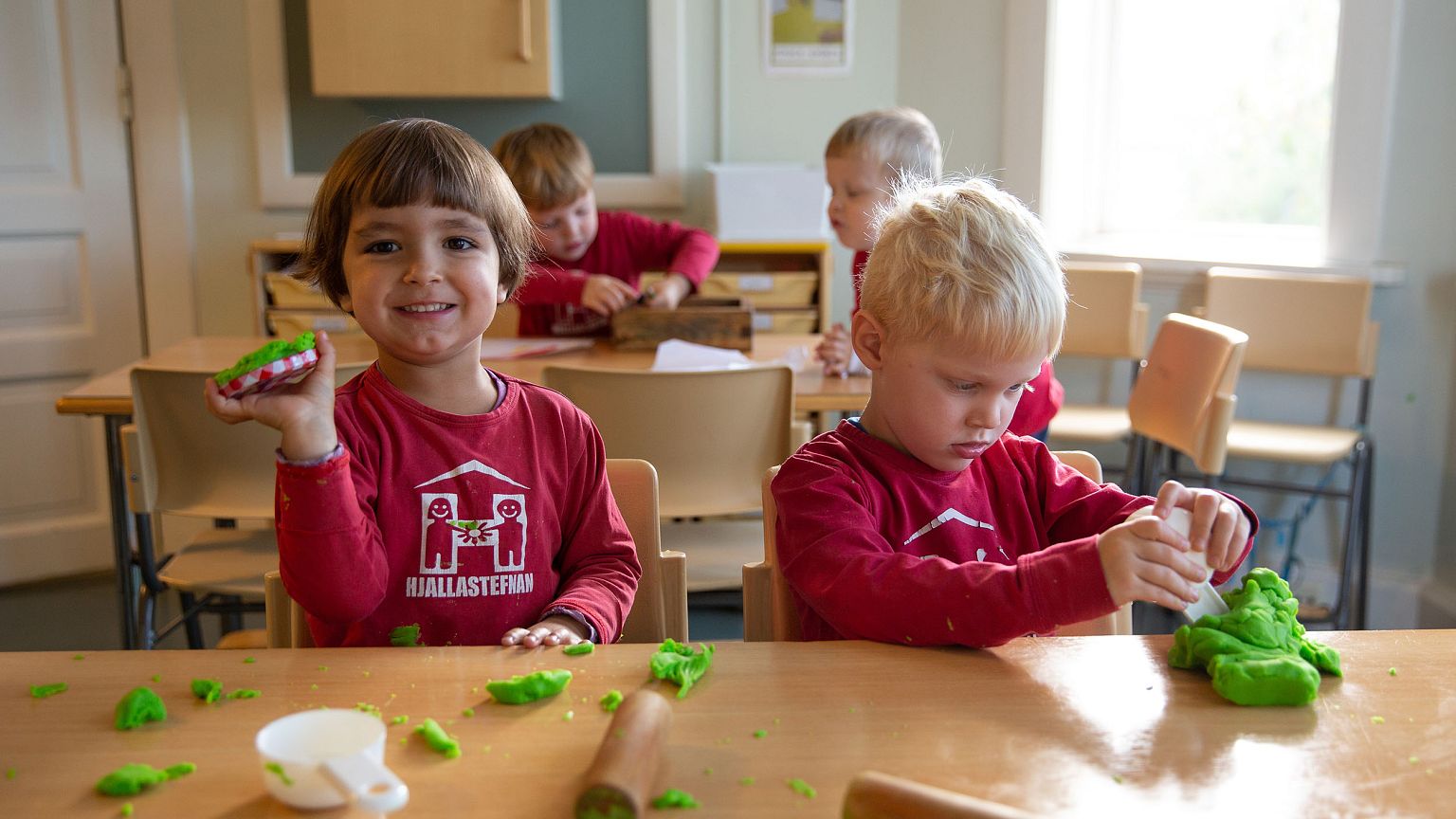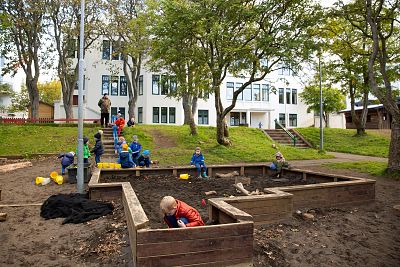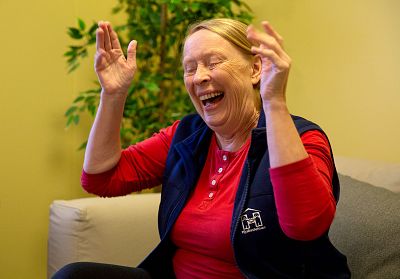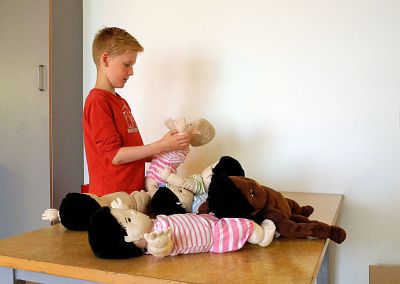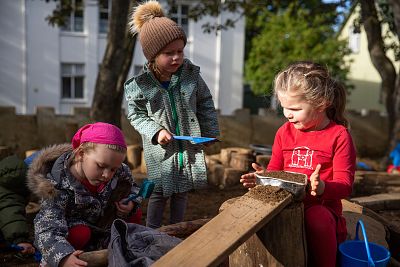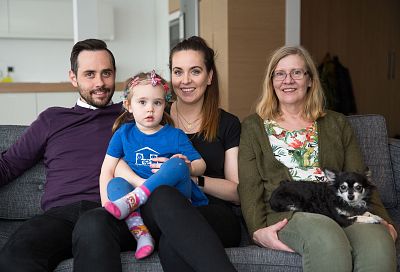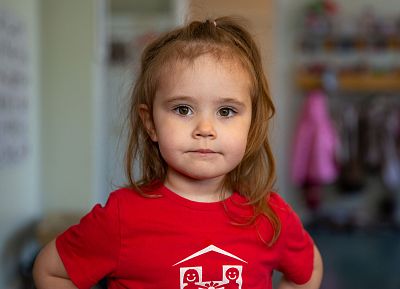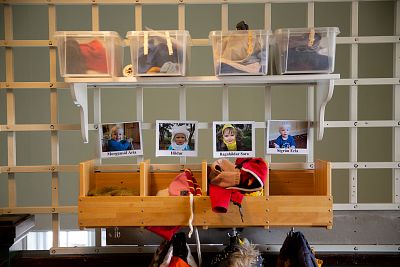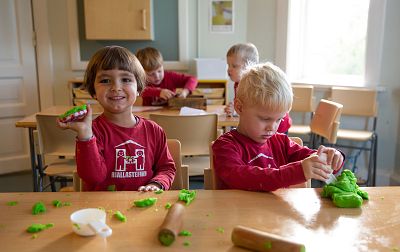Boys put on nail polish and play with gender-neutral dolls, while girls are taught to be more courageous and self-confident.
REYKJAVIK, Iceland — Elia climbed onto the table in front of her classmates. She threw her fists into the air and jumped on to the blue mats below.
"I am strong," the 3-year-old said, her eyes alight with pride and exhilaration.
On the other side of this nursery school in the chic neighborhood of Laufásborg, boys were practicing having "gentle hands" by massaging each other with lotion.
Iceland is consistently rankedfirst in the world for gender equality. But the Hjalli teaching model, as practiced in the nursery school, is considered progressive even in Iceland.
Founded in 1989 by self-described radical feminist Margrét Pála Ólafsdóttir, Hjalli schools aim to counter stereotypical gender roles and behaviors.
Boys and girls are separated for most of the day and they actively compensate for their gender by practicing behaviors usually associated with the other sex: from being daring and taking the initiative to helpfulness and being considerate of others.
"The best way to get closer to equality is to admit the differences," Ólafsdóttir said.
According to the Hjalli theory, by keeping the sexes apart, boys and girls are free to develop their personalities and discover their interests without the pressures and constraints of conventional gender roles and stereotypes. The toys at the schools are all gender-neutral and all of the children wear identical uniforms.
Ólafsdóttir, 60, believes that if children practice only the stereotypical gendered behaviors as society encourages, they risk slipping into what she calls the "blue" and "pink haze."
Found at the two poles of the gender spectrum, this is where the natural strengths of each gender tip over into weaknesses, she explained.
According to Ólafsdóttir, girls' sensitivity and caring natures can turn into self-pity and victimhood, while boys' strength and power can become aggression or even violence.
The teacher turned educational pioneer's ideas have caught on. What was once a controversial experiment is now thriving in this sparsely populated island state, which is home to around 338,000 people.
Three decades after the first Hjalli school was founded, 8 percent of Iceland's nursery-aged children are currently enrolled in one.
'Dolls are only for the boys'
At a nearby Hjalli elementary school one recent day, two 9-year-old boys were pretending to be babysitters.
"We have to get the babies ready because their parents are coming soon," said Óli, as he laid gender-neutral rag dolls out one-by-one under the table in what appeared to be an imaginary bed.
"You have to hold them like this," said his classmate Ári Liljan, cradling a rag doll in his arms.
Their teacher, Kristín Cardew, had lit candles and drawn the blinds of this minimalist classroom. At other stations around the room boys styled each others' hair, painted on nail polish or gave each other full-body massages.
"The dolls are only for the boys, the girls don't need to practice this," explained Cardew, who said she does structured gender compensation work in class about once a week depending on how much she deems it's needed.
The teachers aim to strengthen boys' empathy and caring natures. Meanwhile, the girls are taught to strengthen their courage and self-confidence by running barefoot in the snow without screaming or being direct about how they feel.
World news
"The first variable in life is gender," said Ólafsdóttir, explaining that children often look to the other sex as an example of what not to do — a concept she referred to as "reverse mirroring."
"When you only have girls, there is nothing girly anymore, it's like the gender stereotype goes away," she said. Meanwhile, boys are no longer regarded as "girly" or "sissy" if they show an interest in stereotypically female activities.
But while some of the new behavior may come naturally, Ólafsdóttir cautioned that it had to be reinforced through gender compensation work — from learning to care for younger children to learning to help yourself.
Ólafsdóttir believes that girls are more socially capable, have a stronger "we" identity and seemingly have a natural desire to be caring and helpful.
Boys, on the other hand, are more individual, have a stronger "I" identity, show more initiative and are naturally drawn to games and things more than people.
Cardew said that the boys in her class now enjoyed such compensation activities so much that it had become more of a treat than an obligatory exercise.
But the boys did sometimes fall out of line.
On their way to arts and crafts there was some pushing and shoving. "I have permission to go in front of him," said one boy referring to his classmate. "No, you don't, you never have permission to do that," said Cardew, ordering him back to his original place.
"Kicking and hurting, this is the extreme weakness of the boys," according to Cardew.
For Ólafsdóttir, "kicking and hurting" would fall under the "blue haze."
Controlled crying
In the woods behind the school, the girls' activity was also causing some problems. Participants were supposed to be climbing trees and walking along walls.
"I'm afraid of heights," one girl said. "You've walked along here 100 times," replied her teacher Edda Huld, as she led the way.
Minutes later, another girl called for help saying she was stuck up a tree. "You don't need help, climb down," came Huld's response.
Nearby, two other girls were sulking. "I'll keep an eye on them but they have to decide to talk to me," Huld said, explaining that it was important they learnt to be direct.
Unless it's an actual emergency, the teachers at this elementary school are slow to respond to calls for help.
Crying is particularly discouraged and weeping girls are promptly told to stop.
"People find this a bit ruthless but we're making women weaker by not stopping them," said Cardew, who explained that this was the "extreme weakness" of the girls.
She said that girls have traditionally been "taught to use tears to express ourselves."
For Ólafsdóttir, so-called controlled crying would fall under the "pink haze" category.
Huld agreed that the crying and sulking needed to stop. "What I always say to them is, 'what do you want to take with you when you grow up?'" she said. "Do you want to fill your backpacks with crying and moodiness? Or courage, being able to speak for yourself and independence?"
Three generations
Bára Ragnhildardóttir was part of the first group of students to attend Hjalli nursery school as a two-year-old around three decades ago.
She clearly recalls jumping off tables and running barefoot in the snow. "It gave me courage, it taught me not to be afraid of a challenge," she said.
Ragnhildardóttir, 31, now sends her own daughter Ragnhildur Sara O'Brien to the Laufásborg school.
While she finds it difficult to pinpoint exactly how the model affected her, Ragnhildardóttir said she believes the school helped equip her for later life.
She pointed out that she studied a field that is often "for guys," explaining that she studied computer science alongside only a handful of women before switching to financial engineering.
Now a project manager at a telecommunications company, she said she is often the only woman at meetings.
As a mother, Ragnhildardóttir said it was easier to identify the school's impact on her daughter.
On one occasion, she said, Ragnhildur Sara declined her offer of an audiotape to help her sleep. "She said 'No, Mommy, I'm courageous and strong and I don't need to listen to anything,'" Ragnhildardóttir recalled.
Ragnhildur Sara, she said, would also correct her parents' use of common nouns."She wants to be a policewoman not a policeman," Ragnhildardóttir explained. "It's such a powerful message, teaching her that she is a leader, that she is strong and to love herself, that she has a voice."
World news
Ragnhildur Sígmundsdóttir, Ragnhildardóttir's mother, said it didn't take long for Ólafsdóttir to convince her that the nursery schools were a good idea despite it being a radical idea at the time.
"I believed in making women stronger, that was the goal," said Sígmundsdóttir, 63, who served as one of the first teachers in a Hjalli nursery school in the late 1980s.
Beyond the benefits for her own family, she said she thought the schools had helped promote gender equality in Iceland.
"Because we're so few, it's easy to have a voice in Iceland," she explained, referring to the country's small population.
Sígmundsdóttir added that she thought Icelandic women like Ólafsdóttir had "Viking power" in their bones, alluding to the country's culture of "strong women."
Some attribute that to Iceland's traditionally agricultural economy, where men and women would work the land side by side or women would run the household while their husbands where at sea.
In more recent decades, the country has had a strong women's movement epitomized by the 1975 strike, when women refused to work, cook, clean or look after their children for a day.
Earlier this year, Icelandic lawmakers began putting in place a law requiring companies to prove they are paying women and men equally for the same job.
"If I were a princess and the dragon was there I would find a way out."
The Hjalli model's effect on children remains unclear.
A study commissioned by Ólafsdóttir and conducted by the University of Reykjavik from 2014 to 2016 found that students who attended Hjalli elementary schools had an "increased gender equality awareness" than those in Icelandic public schools.
It also found that a higher percentage of Hjalli students thought parents should bear equal responsibility for family- and home-related duties.
Beyond gender equality, Hjalli students also showed "similar or better" educational achievements when compared to public school students, which had been an early criticism of the model.
News
But Berglind Gísladóttir, a co-author of the report, said not all its findings were positive. She highlighted that by fifth and sixth grade students' attitude to reading was poor as they tended to find it boring.
Kristín Karlsdóttir, an associate professor in education at the University of Iceland, said what struck her when conducting research at a Hjalli nursery was the children's ability to find solutions to complex problems.
"They were always imaginative and were good at working together and using their different strengths," she said, adding that she thought this came from having time to play with little supervision.
But she cautioned that she did not think this was unique to Hjalli but also happened in other well-run Icelandic nursery schools.
Besides skepticism of the model's academic merits, other early criticism focused on the enforced separation of boys and girls. Ólafsdóttir was even accused of trying to change children's sexuality.
Kristín Dýrfjörð, an associate professor in early childhood education at the University of Akureyri and long-time Hjalli skeptic, described the institutions as "elite schools" attended by the children of political, business and cultural leaders.
Hjalli nursery schools are private and cost marginally more than Iceland's public preschools, which parents also must pay for. Sending a child to Laufásborg nursery school full time for a month at the basic rate costs a couple 31,000 Icelandic króna ($281). The bill for a child attending a public nursery school in Reykjavik is around 25,000 króna ($227).
Dýrfjörð said the Hjalli schools' program had not evolved over the past 30 years. "As I see it, early childhood programs have to develop," she said.
She also argued that the Hjalli model's consideration of gender issues is by no means unique in Iceland, where other nursery schools also tackle the problem.
Traditional roles
Back in the woods, it seemed that the message of self-belief had been received by some young girls.
When speaking on the topic of fairy tales, the girls were clear that the traditional roles of the helpless princess and the gallant prince were outdated.
"If I were a princess and the dragon was there I would find a way out," said Katha, 9. "I would not wait for a prince to save me."
Other girls nodded in agreement. Then they started doing warrior poses.















